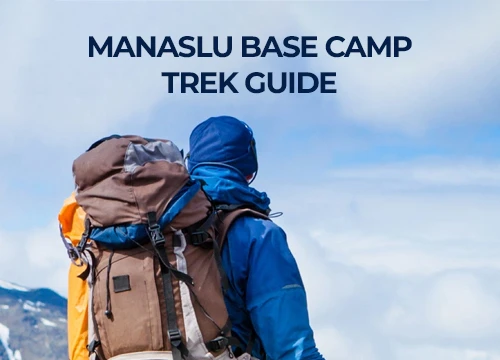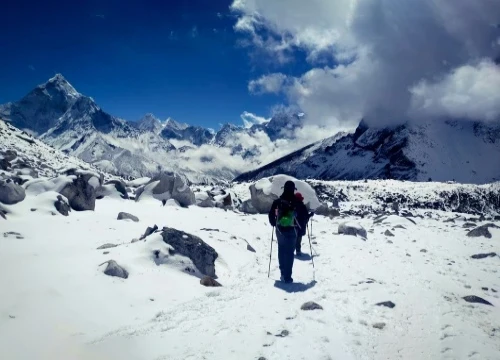How to prepare for Everest Base Camp Trekking in 2024/2025
Maximize your Trekking Potential with These Proven Training Techniques for the 2024 Everest Base Camp Trek
Are you ready to conquer the highest peak in the world? The 2024 Everest Base Camp Trek awaits, and it's time to start preparing. To make the most of this once-in-a-lifetime adventure, you need to maximize your trekking potential through proven training techniques.
In this article, we will guide you through the essential steps to get you ready for the Everest Base Camp Trek. From building strength and endurance to acclimatizing to high altitudes, we've got you covered.
Holiday Tours Nepal, believes that every trekker has the potential to reach new heights. That's why we've compiled a comprehensive list of training techniques that have been tried and tested by seasoned trekkers.
Whether you're a novice or an experienced trekker, our training tips will help you prepare your body and mind for the challenges that lie ahead. We'll provide you with a step-by-step training plan, valuable insights from experienced mountaineers, and expert advice to ensure you make the most of your Everest Base Camp Trek.
Gear up, train hard, and get ready to embark on the journey of a lifetime. The 2024 Everest Base Camp Trek awaits, and with the right training, you'll be well-prepared to conquer the majestic heights of Mount Everest.
The importance of physical fitness for the trek
Physical fitness is paramount when preparing for the Everest Base Camp Trek. This demanding adventure requires strength, endurance, and resilience. Trekking at high altitudes for an extended period of time can be physically taxing, so it's crucial to be in the best shape possible.
To ensure a successful trek, it's recommended to engage in regular physical exercise at least three to four months before the expedition. Building a strong cardiovascular system, increasing muscular endurance, and improving flexibility and mobility are essential components of your training program.
By dedicating time to physical fitness, you'll reduce the risk of injuries, improve your overall trekking experience, and increase your chances of reaching Everest Base Camp successfully.
Training techniques for cardiovascular endurance
Cardiovascular endurance is crucial for the Everest Base Camp Trek. Long hours of walking and climbing at high altitudes require a solid and efficient cardiovascular system. To build cardiovascular endurance, you should focus on activities that elevate your heart rate and increase your lung capacity.
- Aerobic Exercises: Engage in activities such as running, cycling, swimming, or rowing to improve your aerobic fitness. Start with shorter sessions and gradually increase the duration and intensity of your workouts.
- Interval Training: Incorporate high-intensity interval training (HIIT) into your routine to simulate the demands of trekking at varying intensities. Alternate between periods of intense effort and active recovery to improve your cardiovascular fitness.
- Stair Climbing: Climbing stairs is an excellent way to build leg strength and cardiovascular endurance. Find a tall building or use a stair-climber machine to simulate uphill trekking conditions.
By incorporating these training techniques into your routine, you'll enhance your cardiovascular fitness, making the Everest Base Camp Trek a more enjoyable and manageable experience.
Strength training exercises for trekking
Building strength is essential for trekking, as it helps you tackle steep inclines, carry your backpack, and maintain stability on uneven terrain. Incorporate the following strength training exercises into your routine to prepare your muscles for the demands of the Everest Base Camp Trek.
- Squats: Squats target the major muscles in your lower body, including the quadriceps, hamstrings, and glutes. Perform bodyweight squats or add resistance using dumbbells or barbells to increase the intensity.
- Lunges: Lunges strengthen your legs and improve balance. Perform forward lunges, reverse lunges, and lateral lunges to target different muscle groups.
- Planks: Planks are a great exercise for core strength, which is essential for maintaining stability while trekking. Start with a basic plank and gradually increase the duration as your core muscles become stronger.
Remember to maintain proper form and gradually increase the intensity and resistance of your strength training exercises. Aim for at least two to three strength training sessions per week to see noticeable improvements in your trekking performance.
Flexibility and mobility exercises for trekking
Flexibility and mobility are crucial for trekking, as they reduce the risk of muscle strains, improve movement efficiency, and enhance overall performance. Incorporate the following exercises into your routine to improve your flexibility and mobility.
- Dynamic Stretches: Perform dynamic stretches before your workouts to warm up your muscles and increase blood flow. Examples include leg swings, arm circles, and walking lunges.
- Yoga or Pilates: Engaging in regular yoga or Pilates sessions can improve your flexibility, balance, and core strength. These practices also help you relax and relieve stress, which is beneficial for both physical and mental preparation.
- Foam Rolling: Use a foam roller to release tension and tightness in your muscles. Roll your calves, quads, hamstrings, and back to improve mobility and reduce muscle soreness.
Prioritize flexibility and mobility exercises alongside your cardiovascular and strength training workouts. By maintaining a well-rounded training program, you'll enhance your overall performance on the Everest Base Camp Trek.
Mental preparation for the Everest Base Camp Trek
Preparing mentally is just as important as physical training when it comes to Everest Base Camp Trek. The mental challenges of trekking at high altitudes can be overwhelming, so it's crucial to develop a strong mindset. Here are some tips for mental preparation:
- Visualization: Visualize yourself successfully completing the trek and reaching Everest Base Camp. Imagine the exhilaration and sense of accomplishment you'll feel. This technique can help boost your confidence and motivation.
- Breathing Exercises: Practice deep breathing exercises to calm your mind and reduce anxiety. Controlled breathing techniques can also help you manage your energy levels and cope with altitude-related challenges.
- Mental Toughness Training: Engage in activities that challenge your mental resilience, such as cold showers, meditation, or endurance-based workouts. Pushing yourself outside your comfort zone will help you develop mental toughness.
By incorporating mental preparation techniques into your training routine, you'll develop the mental fortitude necessary to overcome obstacles and stay focused during the Everest Base Camp Trek.
Nutrition and hydration tips for trekking
Proper nutrition and hydration are vital for maintaining energy levels, enhancing recovery, and preventing altitude-related illnesses during the Everest Base Camp Trek. Follow these tips to optimize your nutrition and hydration:
- Eat a Balanced Diet: Consume a variety of whole foods, including lean proteins, complex carbohydrates, healthy fats, and plenty of fruits and vegetables. Aim for a well-balanced diet that provides the necessary nutrients for trekking.
- Stay Hydrated: Drink plenty of water throughout the day to stay hydrated. Dehydration can exacerbate altitude sickness symptoms, so it's essential to drink enough fluids.
- Pack Snacks: Pack lightweight, high-energy snacks such as nuts, dried fruits, and energy bars to fuel your body during the trek. These snacks are convenient, provide quick energy, and are easy to carry.
Remember to listen to your body and adjust your nutrition and hydration strategies accordingly. The right fuel and hydration will support your performance and overall well-being on the Everest Base Camp Trek.
Equipment and gear recommendations
Having the right equipment and gear is essential for a safe and comfortable trek to Everest Base Camp. Here are some recommendations:
- Footwear: Invest in a pair of sturdy, waterproof trekking boots that provide ankle support and have a good grip. Break them in before the trek to avoid blisters and discomfort.
- Clothing: Layering is key for trekking in varying temperatures and weather conditions. Pack moisture-wicking base layers, insulating mid-layers, and a waterproof outer layer. Don't forget warm hats, gloves, and socks.
- Backpack: Choose a backpack that's comfortable, durable, and has enough capacity to carry your essentials. Look for a backpack with padded straps and a waist belt for better weight distribution.
- Sleeping Bag: Invest in a good-quality sleeping bag that's suitable for low temperatures. Look for a lightweight, compact option that provides adequate insulation.
Before purchasing any equipment or gear, do thorough research, read reviews, and consult experienced trekkers or outdoor gear experts. Having the right equipment will enhance your comfort and safety on the Everest Base Camp Trek.
Safety precautions and emergency preparedness
Trekking to Everest Base Camp involves inherent risks, so it's crucial to prioritize safety and be prepared for emergencies. Here are some safety precautions to keep in mind:
- Acclimatization: Acclimatize properly by spending a few days at intermediate altitudes to allow your body to adjust to the high altitude. This reduces the risk of altitude sickness.
- Travel Insurance: Purchase comprehensive travel insurance that covers medical emergencies, evacuations, and trip cancellations. Ensure the policy is suitable for trekking at high altitudes.
- First Aid Kit: Pack a well-stocked first aid kit that includes essential medications, bandages, antiseptics, and any personal medications you may require.
- Trekking with a Guide or Group: Consider trekking with a knowledgeable guide or as part of a group. They can provide guidance, support, and assistance in case of emergencies.
Always follow the guidance of experienced mountaineers, trekking agencies, and local authorities. Prioritize your safety and take necessary precautions to ensure a safe and enjoyable Everest Base Camp Trek.
Conclusion and final tips for a successful Everest Base Camp Trek
Congratulations! You're now equipped with the knowledge and training techniques to maximize your trekking potential for the 2024 Everest Base Camp Trek. Remember these final tips to ensure a successful and enjoyable experience:
- Start Early: Begin your training and preparation well in advance to allow ample time for physical and mental conditioning.
- Listen to Your Body: Pay attention to your body's signals and adjust your training and trekking pace accordingly. Rest when needed and seek medical attention if necessary.
- Enjoy the Journey: The Everest Base Camp Trek is not only about reaching the destination but also about embracing the beauty of the journey. Take the time to appreciate the stunning landscapes, connect with fellow trekkers, and immerse yourself in the experience.
- Stay Positive: Trekking to the Everest Base Camp is a challenging endeavor, but with the right mindset, determination, and training, you can conquer it. Stay positive, believe in yourself, and enjoy the incredible adventure that awaits.
Gear up, train hard, and get ready to embark on the journey of a lifetime. The 2024 Everest Base Camp Trek awaits, and with the right training, preparation, and mindset, you'll be well-prepared to conquer the majestic heights of Mount Everest.
Good luck on your Everest Base Camp trek!





